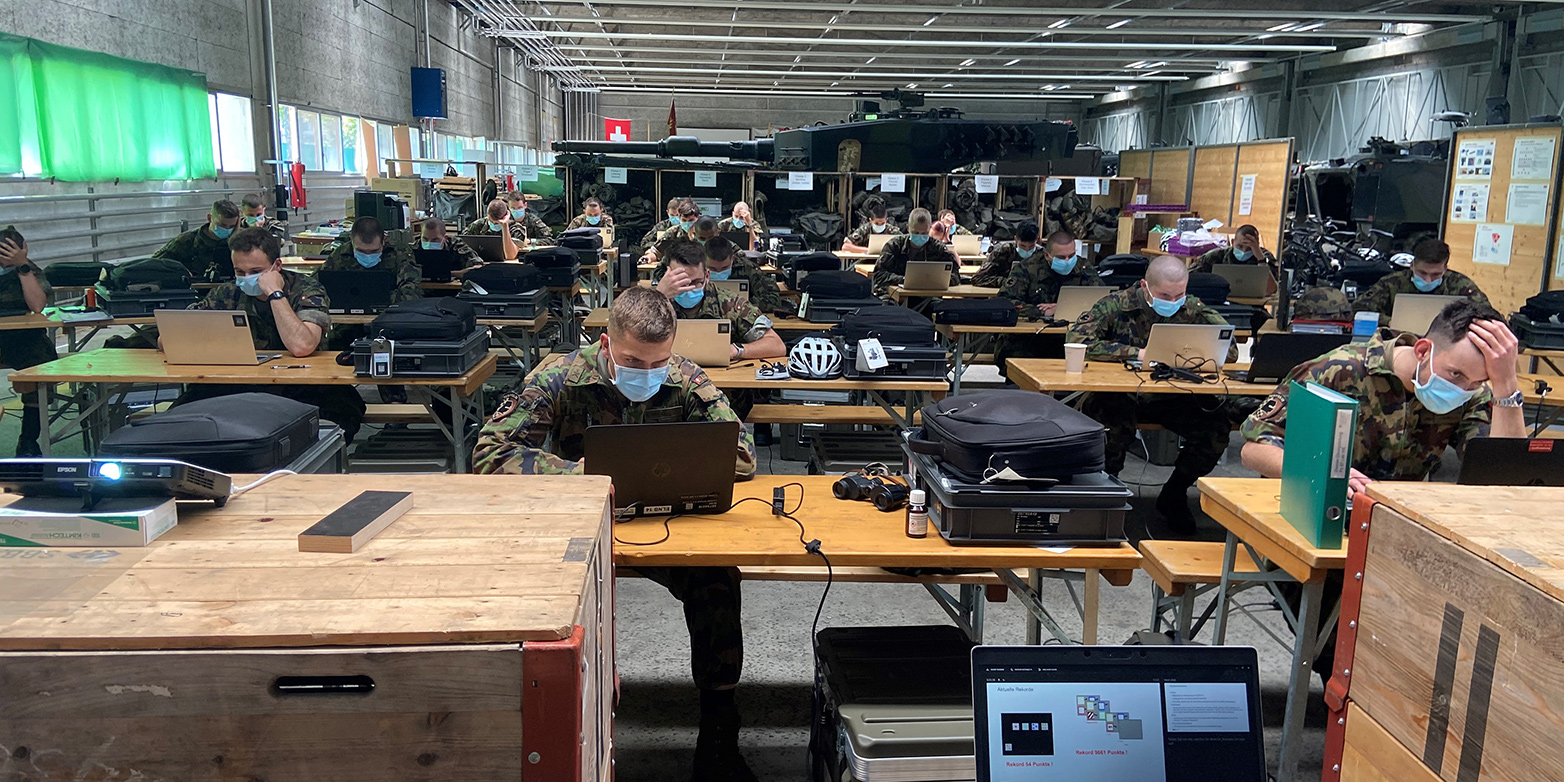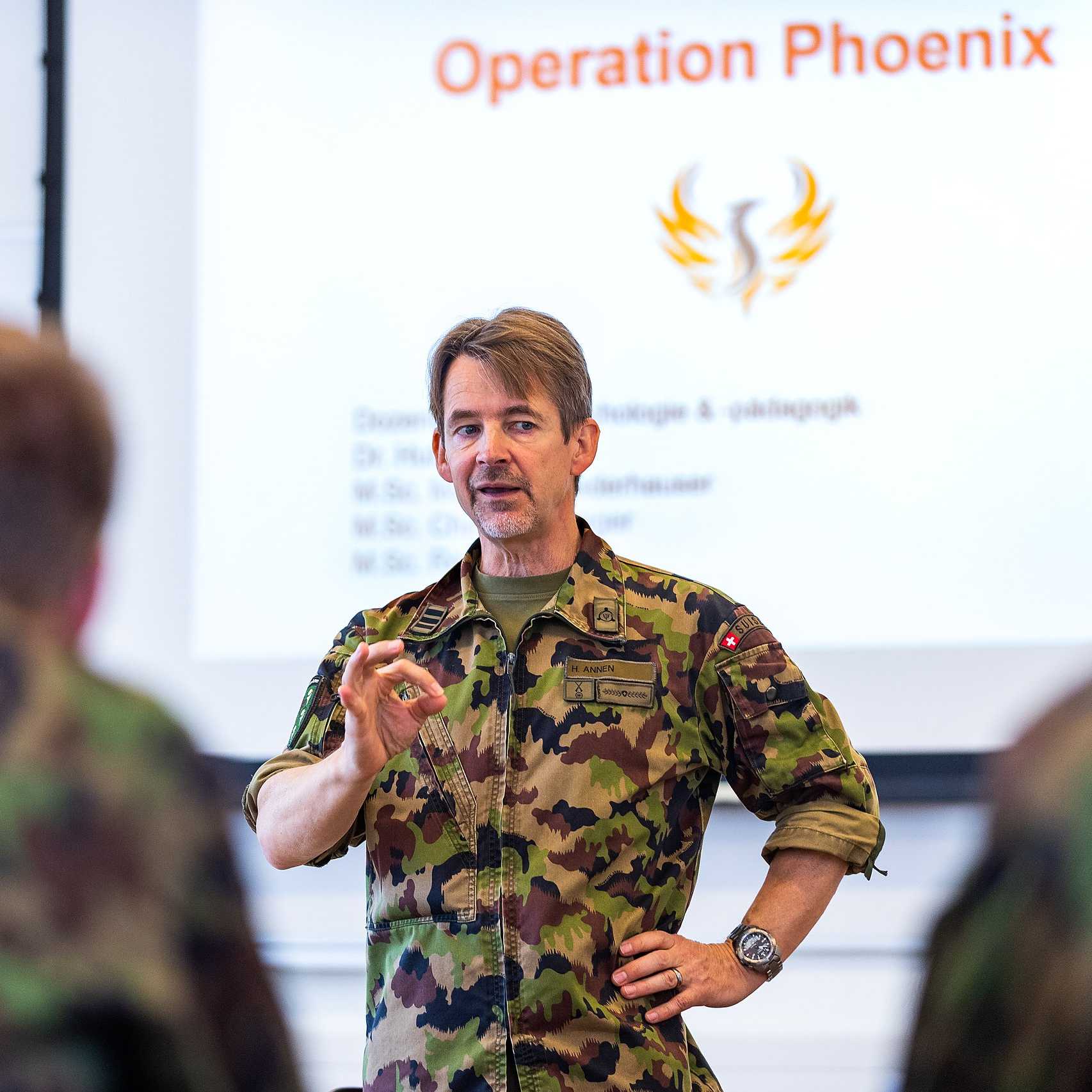Cognitive flexibility improves leadership, according to numerous studies conducted by ETH Zurich researchers. The Swiss Armed Forces are planning to employ this knowledge in the training of officers to better prepare them for future crises.

For over six months, Ukrainian forces have successfully defended their country against a superior enemy. In addition to Western weaponry, one reason for this, according to military experts, is that the Ukrainian army is more flexible. Again and again, it has managed to catch the comparatively slow and inflexible Russian troops off guard by quickly and creatively responding to new situations.
This requires leaders with a high level of cognitive flexibility that are able to correctly assess whether a problem calls for new solutions or whether it can be solved by employing established procedures.
Fortunately, the Swiss Armed Forces have never experienced war deployments such as in Ukraine. They have, however, recognised the significance of this ability, which they plan to emphasise in the future. Because up until now, unlike other mental capabilities, cognitive flexibility has not been explicitly taken into account in officer recruitment or training. As with other peace armies that do not engage in combat missions, the Swiss Armed Forces' focus is more on the proper implementation of established rules and routines.
A new collaboration between ETH Professor Stefano Brusoni's Technology and Innovation Management research group and the Swiss Armed Forces is looking to change that: "To be prepared for future crises, we intend to focus more on cognitive flexibility in training and recruitment - with the help of ETH Zurich," explains military psychologist Hubert Annen of the Military Academy at ETH Zurich. Annen is heading the project on behalf of the Swiss Armed Forces. The project aims to facilitate the shift towards a more innovative and adaptive army.
Between implementation and creative questioning
Leaders are creatures of habit just like everybody else: they tend to repeat procedures they are familiar with. This works out for them until they encounter unexpected situations that call for new solutions. All of a sudden, approaches that used to work in the past no longer provide a decent road map for the present.
"These kinds of situations call for cognitive flexibility," Daniella Laureiro-Martínez explains. Together with Professor Brusoni, the researcher has studied the mental adaptability of leadership personnel for over 14 years. "Cognitive flexibility is the ability to adapt one's thinking and actions to a changing environment," she says. Without this ability, organisations are incapable of change and prone to inertia.
In numerous lab experiments involving business leaders, Laureiro-Martínez was able to demonstrate that people with high cognitive flexibility do better on many standardised tests. "More flexible managers perform better because they can timely switch between an analytic but slow mode of decision-making and one that is implementation-oriented and fast in ways that are right for the situation," she says. With the help of fMRI scans and other methods, she was able to find the key brain regions responsible for switching appropriately between these two modes of decision-making.

'Being taught in the army how to flexibly respond to problems in ways that are appropriate to the situation also benefits one's civil career.'
Hubert Annen
Leaders with high cognitive flexibility intuitively recognise whether a problem has a clear structure and can be solved quickly using standardised procedures or whether it calls for a more detailed analysis and new solutions. "Efficient problem-solving requires a balance between implementing old routines and creatively searching for new ways forward," Laureiro-Martínez says. Constantly pursuing new avenues when there is no need to do so is a great waste of time and energy. On the other hand, opting too readily for old solutions when faced with new problems can lead to bad decisions.
Cognitive flexibility improves military performance
But do the findings about managers from Laureiro-Martínez and Brusoni's numerous studies also apply to military leaders? And what neurocognitive capabilities are key to training cognitive flexibility? An experiment involving over 200 officer candidates explored these questions. The experiment was conducted by Jan Richner, a doctoral student at the Chair of Technology and Innovation Management, who initiated the collaboration.
Richner, himself an army officer, had the officer candidates complete a series of standardised decision tests that also tested for cognitive flexibility. He found out that more flexible cadres achieved better test results. What's true for managers seems to apply to military leaders as well.
But it didn't stop there. In a second step, Richner examined whether cognitive flexibility also affected military performance outside the lab. The clarity of his findings surprised even him. Not only were flexible officers rated more favourably by their superiors; statistical analyses also showed that cognitive flexibility is one of the most important factors for an officer candidate's overall military performance - more important than, say, their demeanour, their teamwork skills or their emotional stability.
Richner was also able to demonstrate that officer candidates who showed a high degree of cognitive flexibility in the lab possessed a number of other characteristics as well. These include the ability to concentrate over long periods of time as well as the ability to grasp, incorporate and recall information. Recognition of relevant changes in the environment and suppression of established modes of thought and action to open the way for new ideas also have a positive effect on the candidates' flexibility.
A training programme for Swiss officers
The Swiss Armed Forces now intend to take the ETH researchers' findings into account when recruiting officers. "In future, we want to examine officer candidates' cognitive flexibility in our assessment centres," Annen says.
On top of that, cognitive flexibility is set to become an integral part of the training and evaluation of Swiss Armed Forces cadres. There are plans for training units in the lecture hall and in the field to improve future cadres' adaptability. What this training programme will look like in detail is currently being defined by Richner, Annen and Dominik Belser, the commander of the Tank and Artillery officer school in Thun, Switzerland. Pilot experiments will commence this fall.
The Swiss Armed Forces are hoping that their collaboration with ETH Zurich will make a career as an officer a more attractive choice. "Being taught in the army how to flexibly respond to problems in ways that are appropriate to the situation also benefits one's civil career," Annen explains. One of the ETH researchers' goals in working with the Swiss Armed Forces is to incorporate their findings into ETH's continuing education programmes such as the Executive MBA ETH Zurich and University of St. Gallen.
References
Laureiro-Martínez D, Brusoni S. Cognitive flexibility and adaptive decision-making: Evidence from a laboratory study of expert decision makers. In: Strategic Management Journal, Volume 39, Issue 4, April 2018, 1031-1058, doi: external page10.1002/smj.2774
Laureiro-Martínez D, Brusoni S, Canessa N, Zollo M. Understanding the exploration-exploitation dilemma: An fMRI study of attention control and decision-making performance. In: Strategic Management Journal, Volume 36, Issue 3, March 2015, 319-338, doi: external page10.1002/smj.2221






